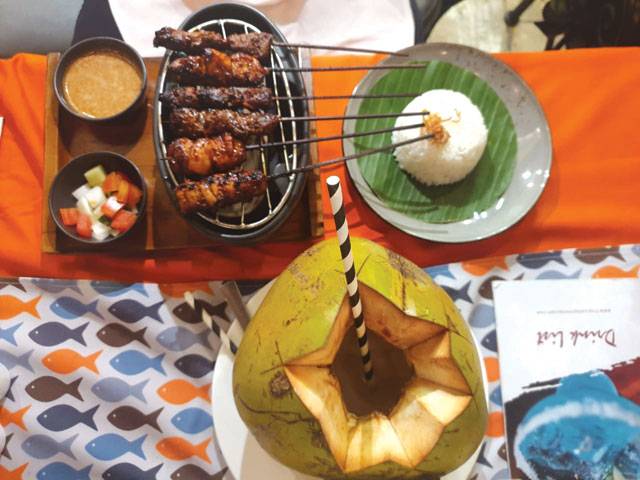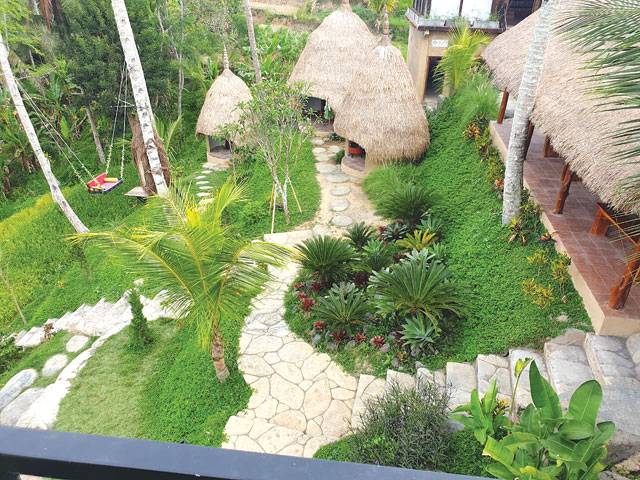AGENCIES-Indonesia is one such country where a tourist becomes a millionaire instantly on arrival as soon as one walks out of the money changer kiosk. Indonesian currency known as Indo Rupee is Rs14,000 for an exchange of $1. Having said that , the country’s claim to fame is not only as one of the world’s most Muslim populated nation but Indonesia is inhabitant of 6,000 plus touristic islands of which Bali takes the cake away. Also known as the land of the gods, Bali’s raison d’etre is its natural beauty; looming volcanoes, treasure trove of islands and lush terraced rice fields which makes this heaven on earth.
Being closest to Australia and tempting tropical climate, number of Austrian tourists outnumbers others in Bali. However, the Asians find the weather unfriendly during November and it is not advisable to explore the island during baking heat in day time. As night falls, the hustle bustle breaks away the boredom and the island comes alive. It was interesting to note that food vendors take most of the space, offering street food when the sun is down and the shops are closing up.
At the corner of every street in commercial hubs and beach resorts of Bali namely Kuta, Seminyak or Nusa Dua there are pampering Spas to be found on a very nominal price. The visitors to these Spas are a mix when it comes to gender. Men mostly opted for full body massage whereas women prefer herbal or foot massage. A Spa costs around $10 for a full body massage but then sky is the limit depending how much one wants to be pampered.
Commuting in Bali is very much affordable. Uber, taxis as well as rent-a-car services are within $7 to $10 within the radius of 10 km. If one is in a tight supply of wherewithal, motorbike ride will cost you under $5.
Bali is by all means a complete package for a tourist. This ethereal island is a Mecca for the honeymooners but value for money for retired couples as well as world travellers. Balinese cuisine, Spas, temples and cultural traditional dances easily fill up a tourist’s itinerary for a week as per the budget that the pocket allows. The hospitality at Balinese hotels, resorts, restaurants and even Spas is a Je ne sais quoi and visitors do get carried away.
Indonesia cuisine commonly includes rice, noodles and soup dishes, however the island populace is predominately Hindus and culinary traditions are somewhat distinct with the rest of Indonesia. Many special foods in Bali are prepared for the offerings for the deities, as well as other dishes consumed on special occasions are also in line with the religious restrictions.
However for a tourist the menu at the eateries have rich flavors; savory, hot and spicy but also a combination of basic taste as sweet, sour, salty and even bitter. Sambal, a hot and spicy chili sauce with shrimp paste, is a staple condiment at all Bali eateries. Indonesia is a home of Sate, country’s most popular dish made from thinly slice and finely chopped shallots, garlic, ginger and chili blended with lime leafs and coconut paste. Once marinated, it is cooked laid on lemon grass stalk or wooden skewer and grilled to perfection.
Bali has a strong rice agriculture tradition going back centuries old intricate network of sophisticated irrigation system. The Balinese water temples regulate the water allocation of each village’s rice fields in the region. Balinese Hinduism revered Dewi Sri as an important rice goddess. The rice is called Nasi and do not be surprised to try different kinds of it.
The other customary set of meal in Bali gastronomy is called Sela and it includes rice, meat and vegetables. It is traditional that one Sela is eaten by eight people where they would often sit in circles and share the food in front of them.
Bali is very famous for Kopi luwak coffee, also known as civet coffee. It is named after the practice of weasel-like animal called civets let loose into coffee plantations at night to eat the juiciest ripe coffee berries. Although Luwak coffee is damage on the pocket for being steeply priced, the free sampling of a wide variety of coffee which comes with it, makes it worth the money. All along the road sides driving from Ubad a rice paddy field town and heading towards more commercial town of Simanyak, one finds a wide ranging of wood carving artefacts and furniture on display. It is being said that wood carving evolved in Bali as a form of spiritual devotion and until 20th century carving was used for temples and palaces only. These carvings are made from ancient banyan tree roots and local woods notably jackfruit, crocodile wood or hibiscus or sandalwood.
When in Bali, visit to Mount Batur is a must see. An active volcano located at the center of the two concentric calderas on the island of Bali last erupted in 2000.
To get into the heart of culture, a visit to Pura Tirta Empul is a must. This place of worship is considered one of the holiest of temples in the area. For over a thousand years, Balinese Hindu worshippers have been drawn to its sacred springs which is said to have been created by god Indra and possess curative properties.
The trip to Bali cannot be complete without witnessing Uluwatu Kecak and fire dance also known as Kecak. It is a form of Balinese Hindu dance and music drama that have been performing in Bali for many many years, expressing stories of dance drama through bodily gestures including gestures of fingers, hands head and eyes. The performers are dressed in multi color attires and makeup over done.
The moods became somber as the whole week came to an end and it was time to leave. One week is too short of a trip to Bali so do not plan a Bali trip foolishly if you want to unwind, do some soul searching and marvel at God’s creations, do not come back before 15 days.
Wednesday, November 20, 2024
Indonesia: Where a tourist becomes millionaire instantly




8:56 AM | November 07, 2024
CM Maryam launches country’s first dialysis card programme
November 20, 2024
Envoy celebrates Week of Italian Cuisine with culinary tapestry
November 20, 2024
Lebanon’s beleaguered army in the spotlight as truce efforts intensify
November 20, 2024
Sharjeel inaugurates People’s Bus Service’s command, control centre
November 20, 2024
-
Hunger crisis to increase in South Sudan, warns UN
-
Hunger crisis to increase in South Sudan, warns UN
-
Pakistan’s judiciary champions climate justice at COP29 in Baku
-
Punjab struggles with persistent smog as Met Office forecast rainfall
-
Punjab residents face escalating smog crisis as pollution levels soar across country
-
Qatar says Hamas 'no longer welcome' in Gulf state
Sindh & Indus
November 19, 2024
Another US Escalation
November 19, 2024
Questionable Criticism
November 19, 2024
Stability in Sight
November 18, 2024
Police Accountability
November 18, 2024
Why Not Use AI to Address Climate Change?
November 19, 2024
Drones in Pakistan
November 19, 2024
Thar Coal Gasification
November 19, 2024
The Law of Nations
November 18, 2024
Living in a Haze
November 18, 2024
ePaper - Nawaiwaqt
Nawaiwaqt Group | Copyright © 2024





